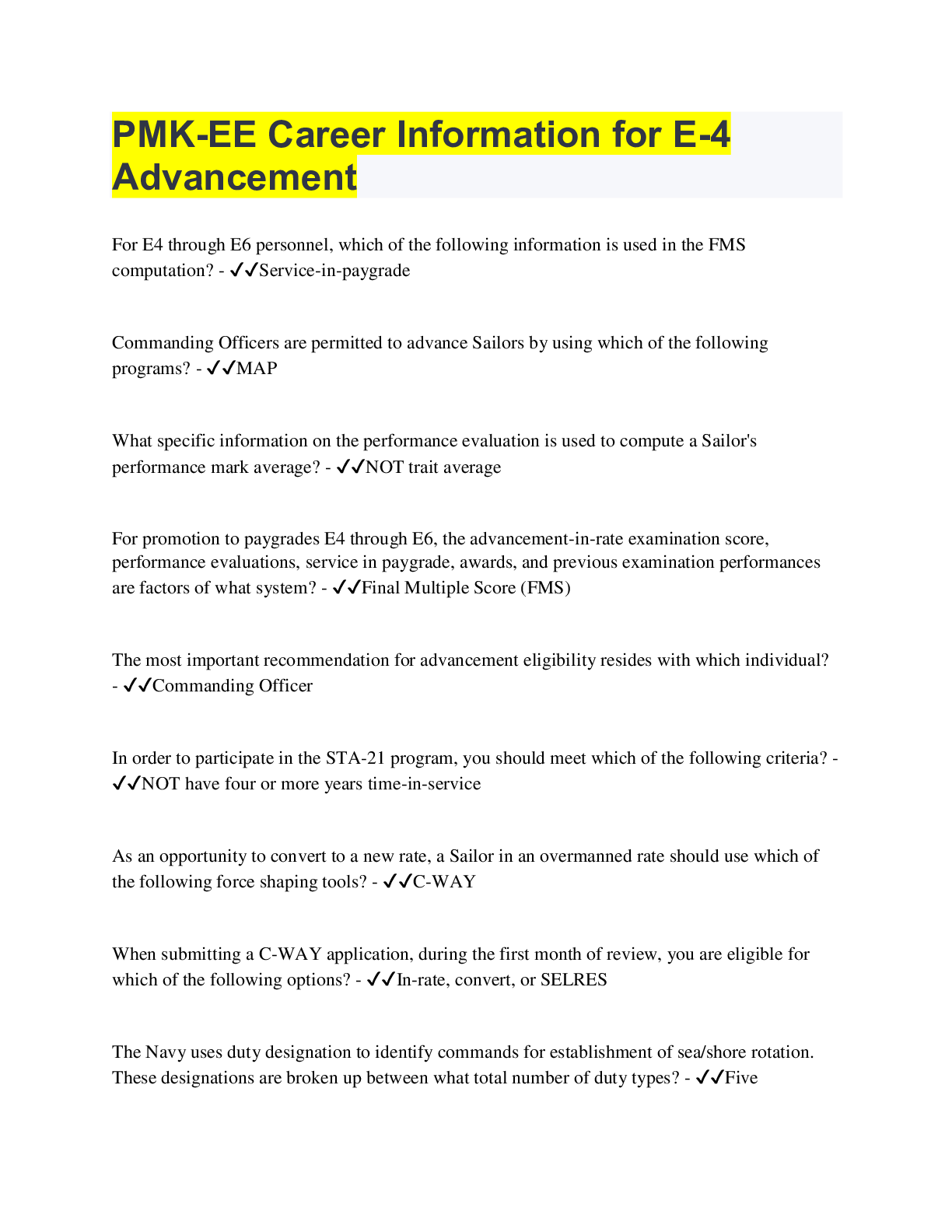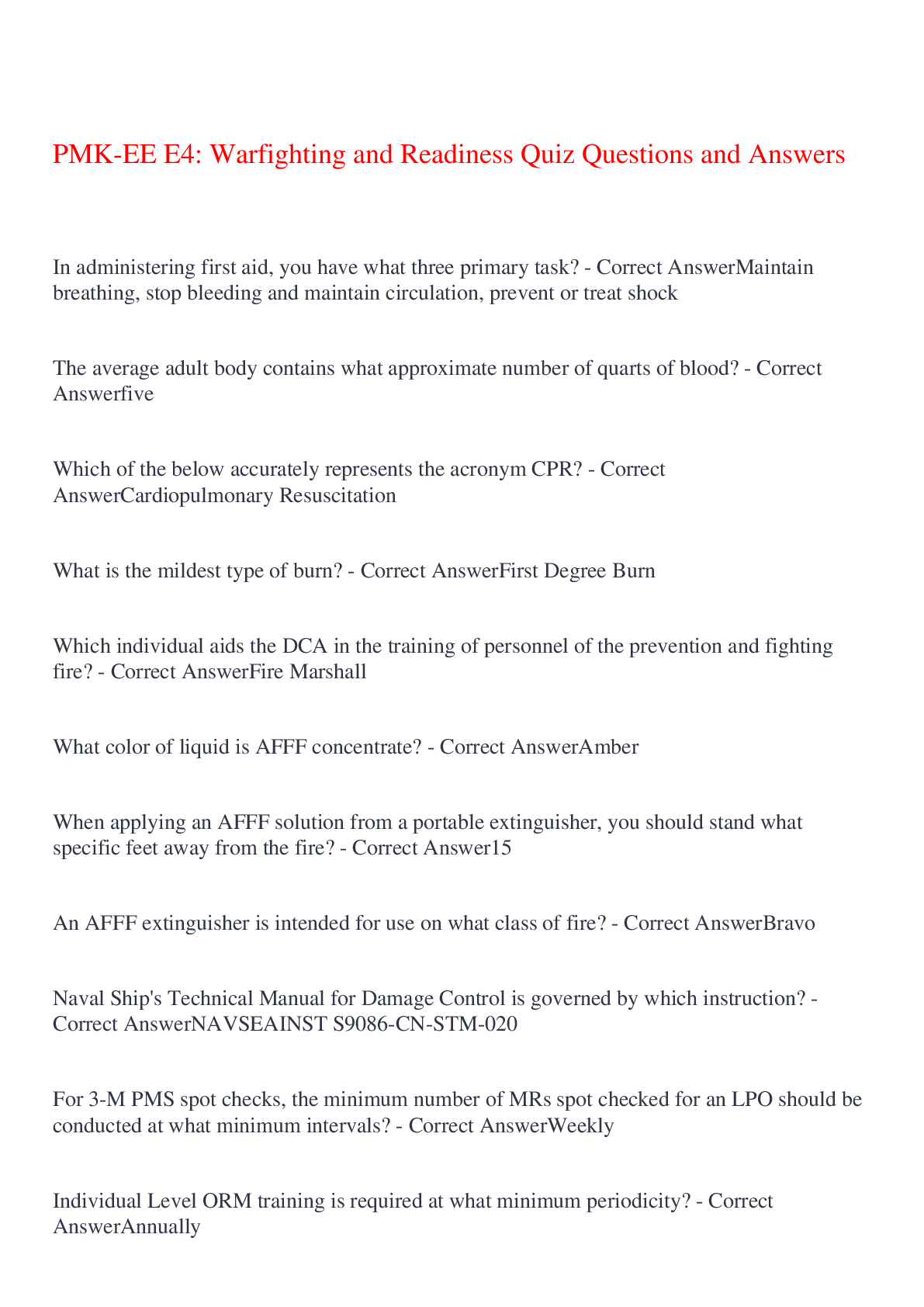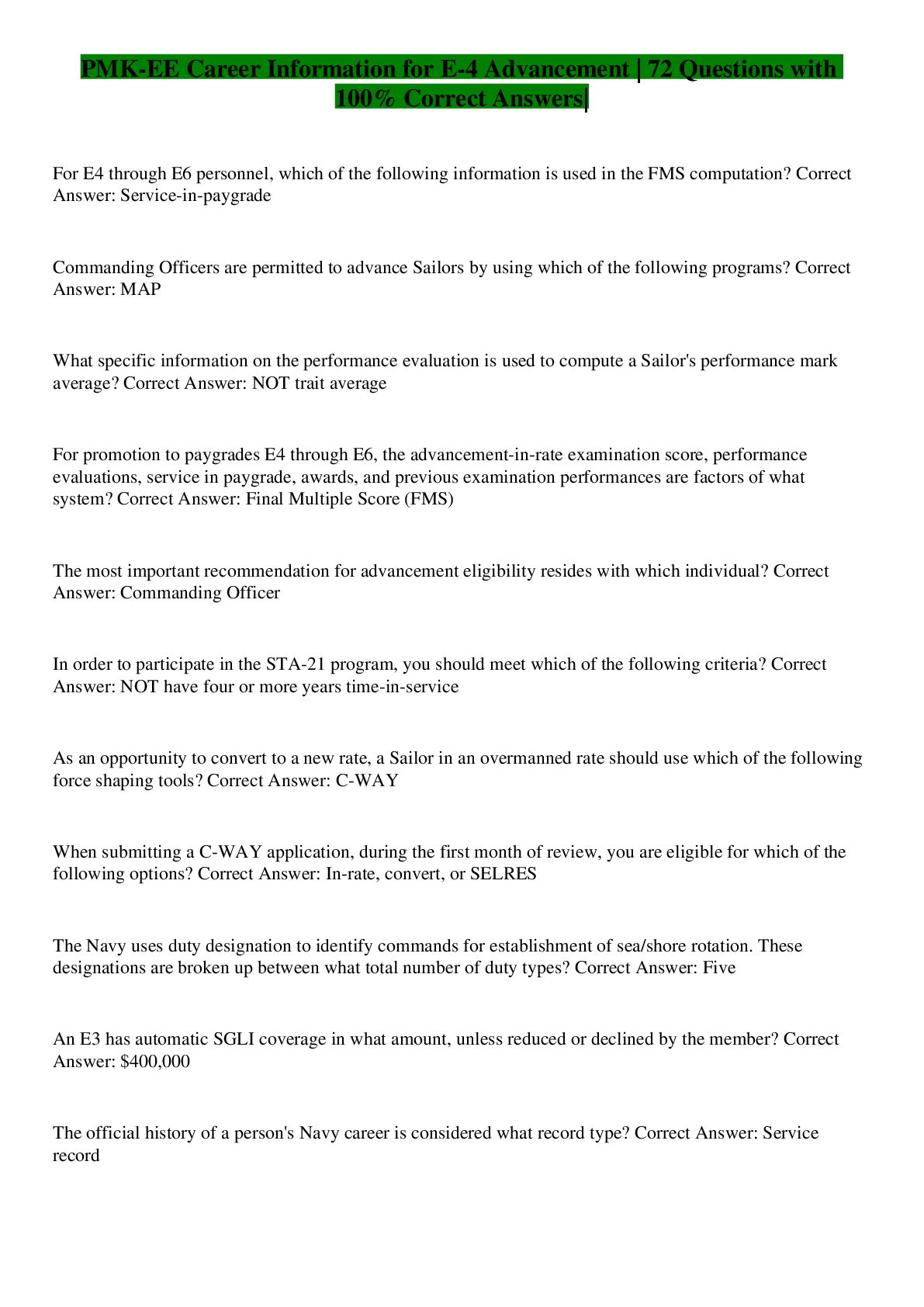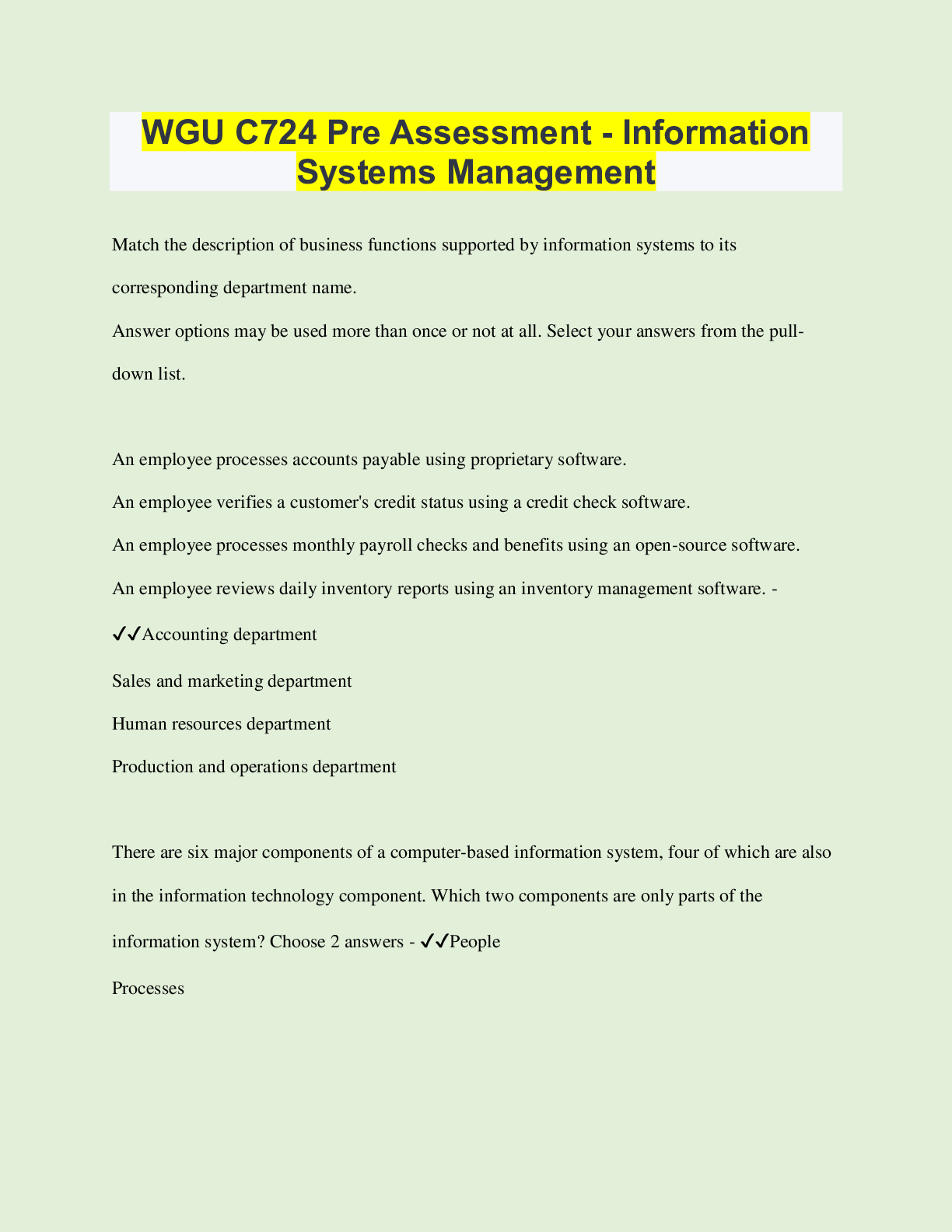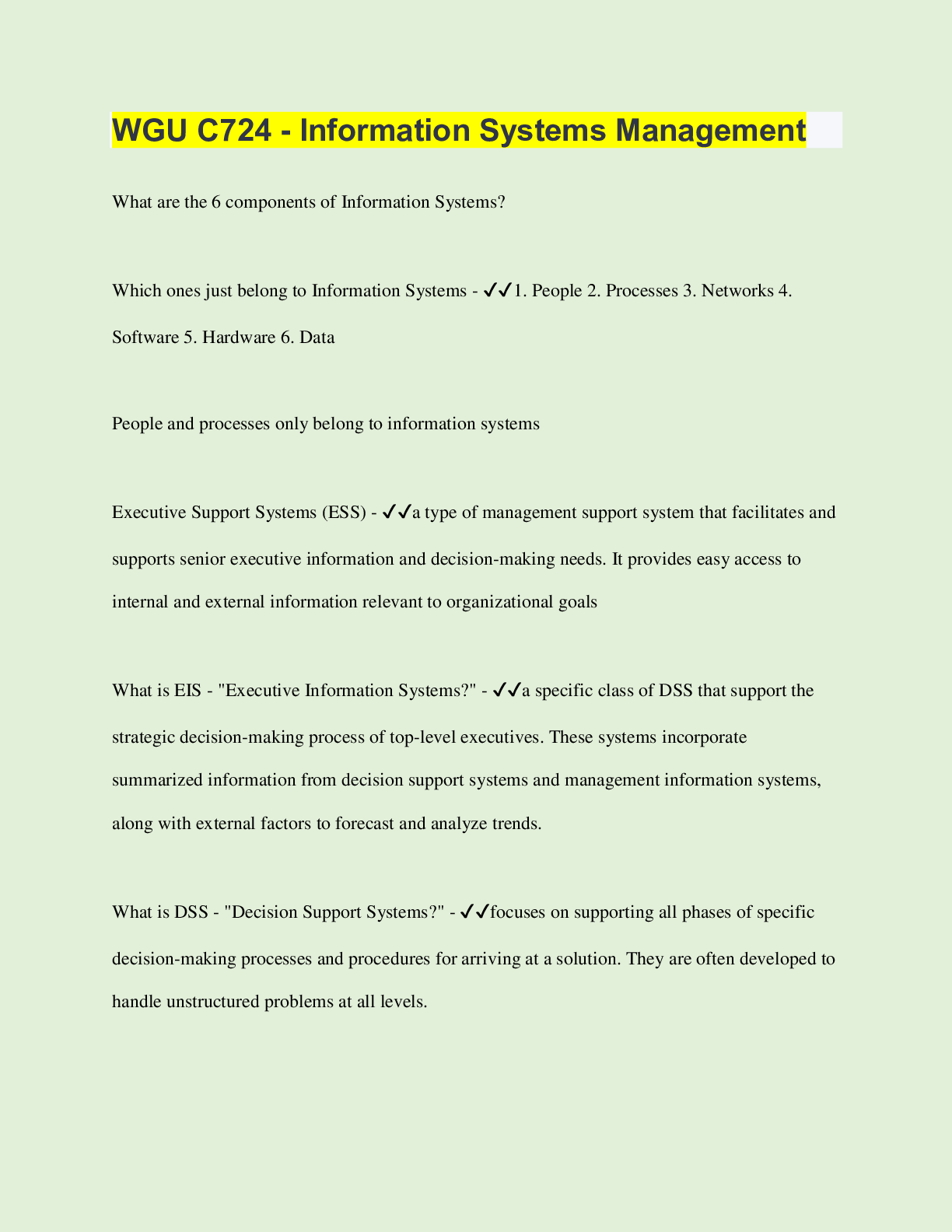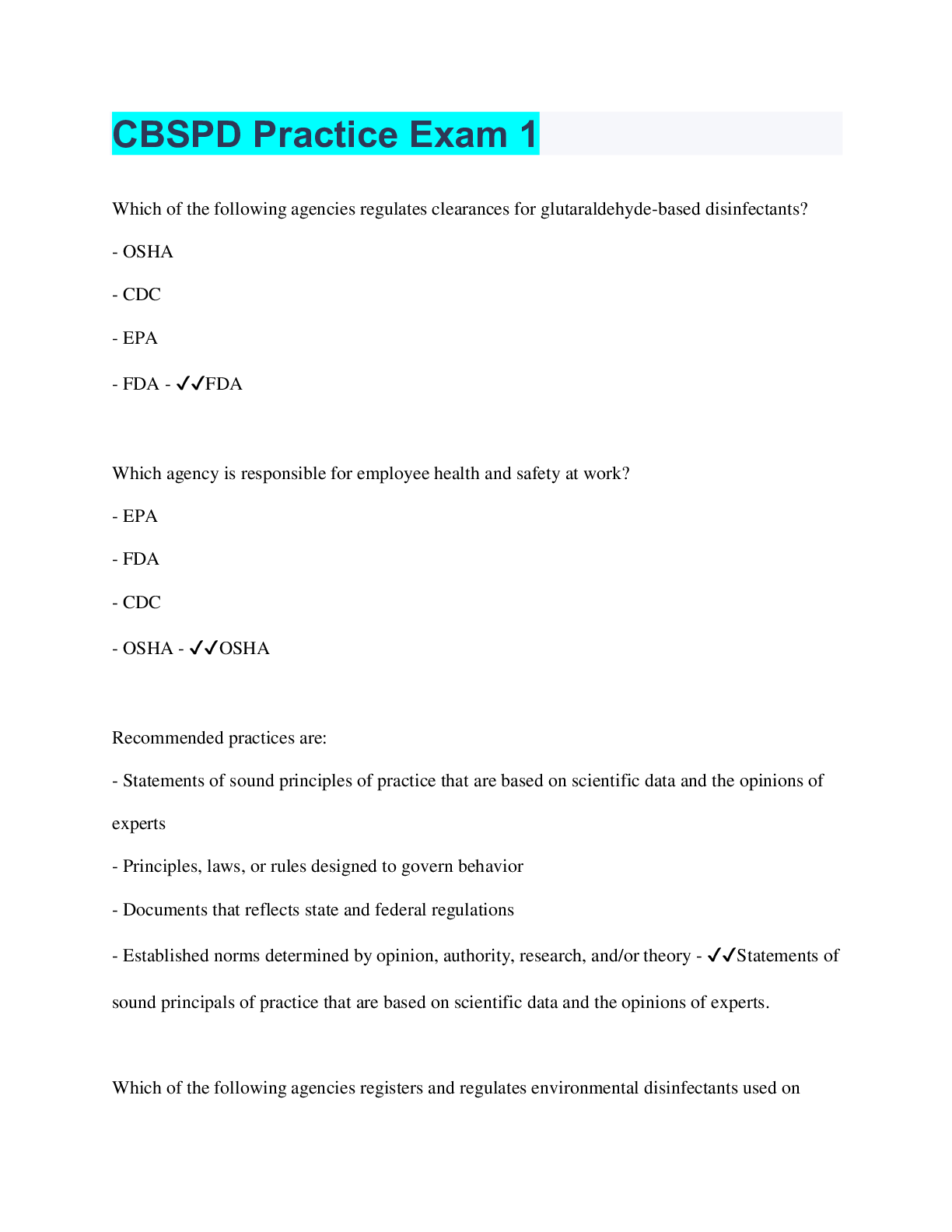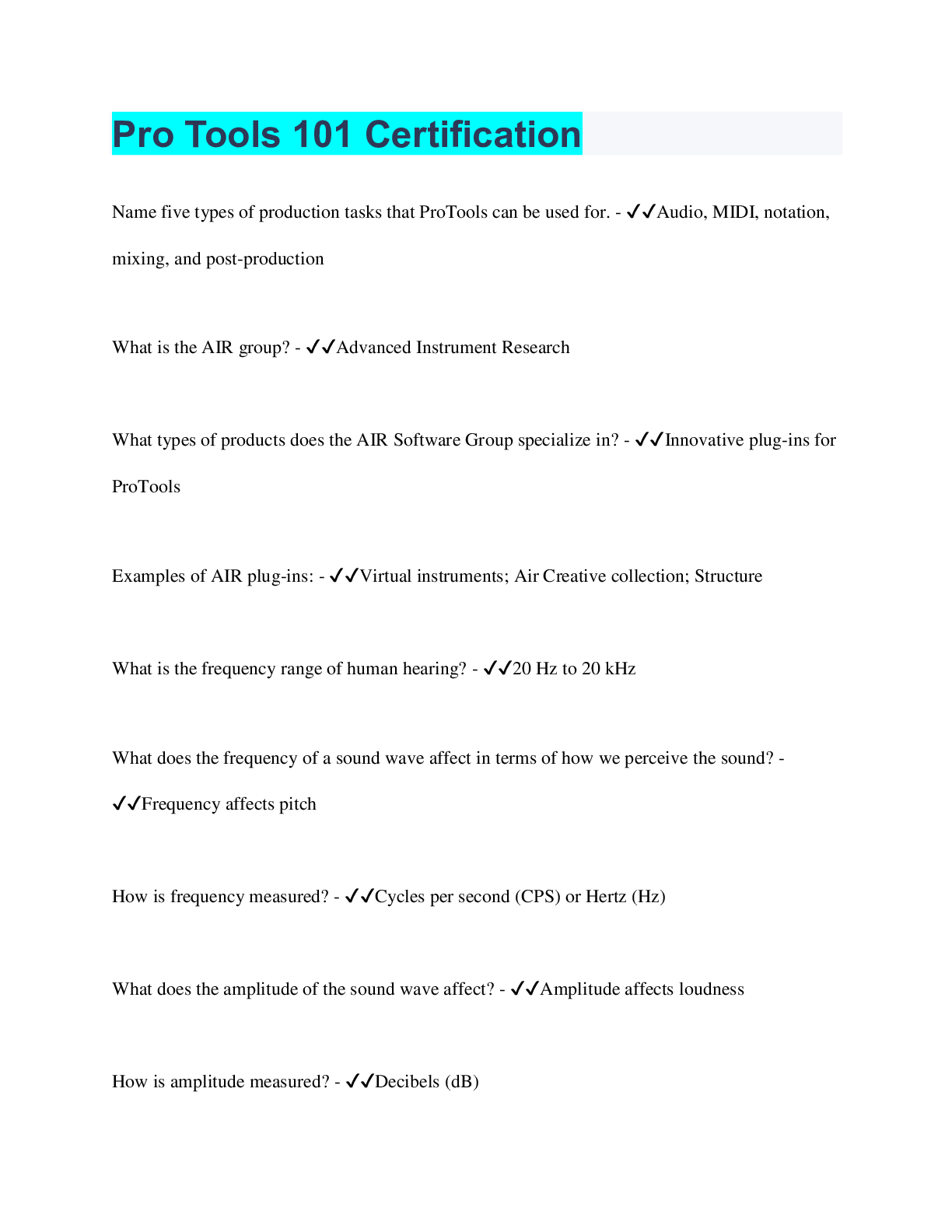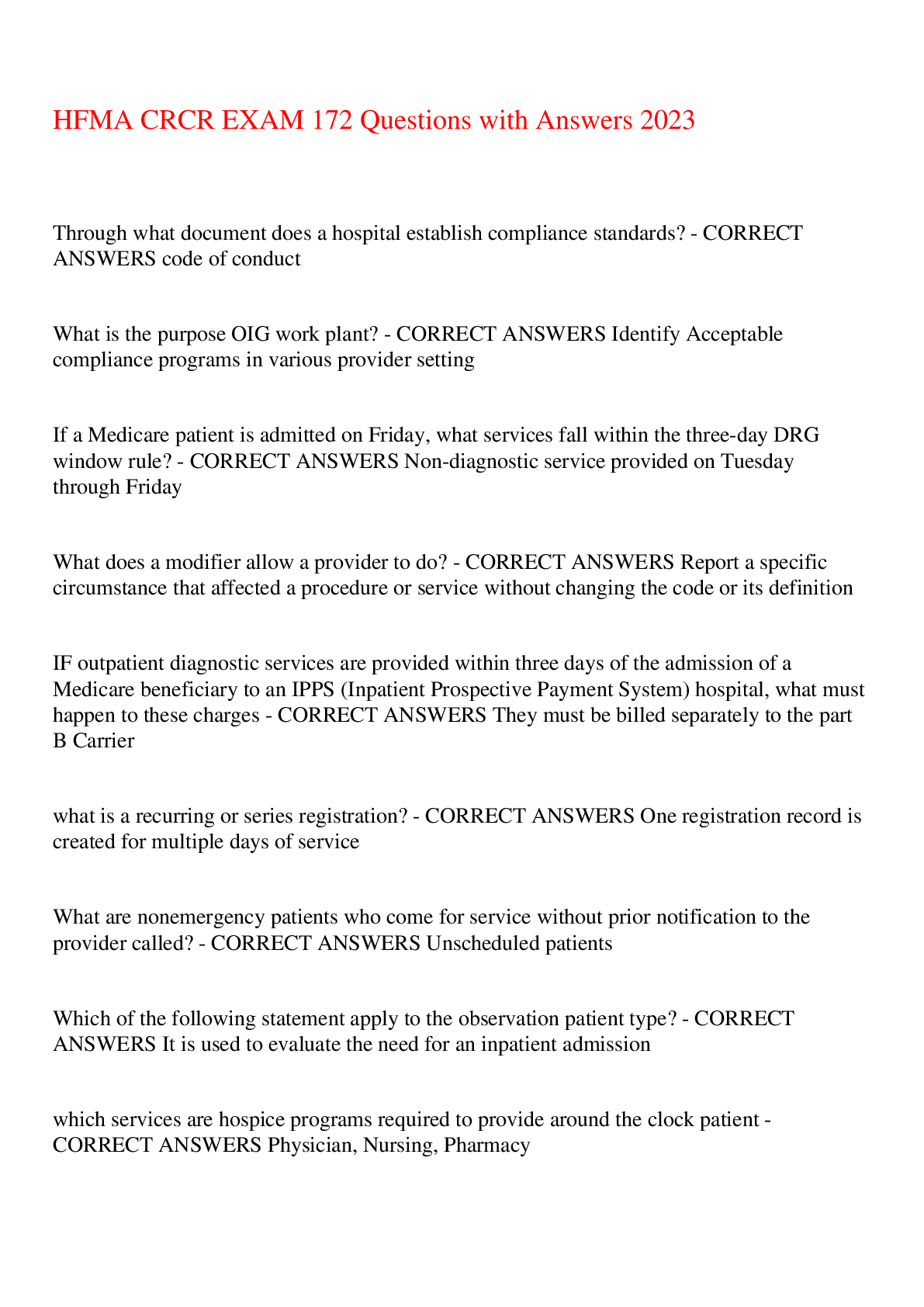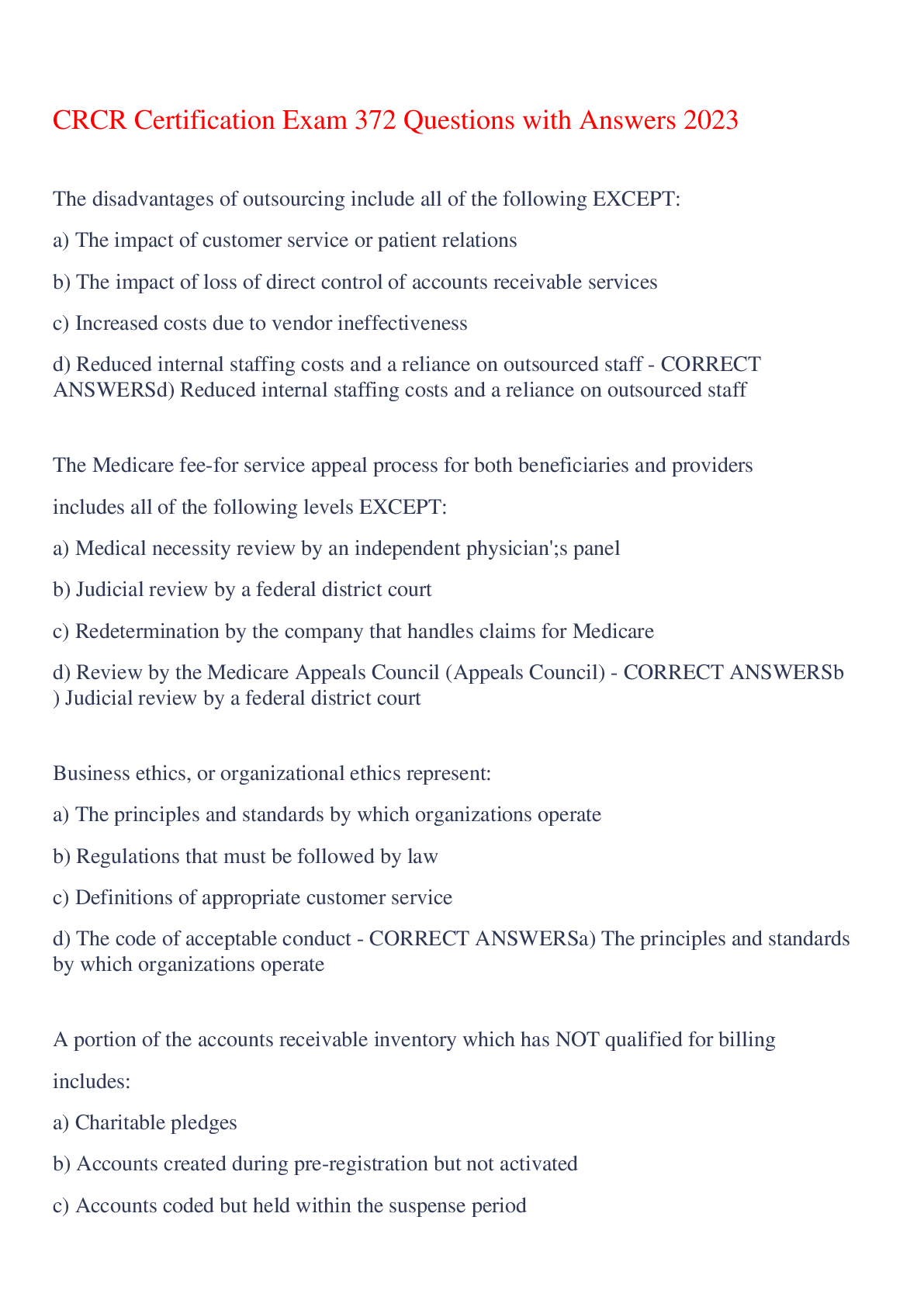CNRN Exam 72 Questions with Verified Answers,100% CORRECT
Document Content and Description Below
CNRN Exam 72 Questions with Verified Answers Cerebral circulation - CORRECT ANSWER completely dependent on glucose for metabolism anterior lobe of pituitary gland - CORRECT ANSWER GSH ACTH TS... H Prolactin FSH LH posterior lobe of pituitary gland - CORRECT ANSWER vasopressin and oxytocin and antidiuretic hormone pons - CORRECT ANSWER sleep and arousal RAS location frontal lobe - CORRECT ANSWER A region of the cerebral cortex that has specialized areas for movement, abstract thinking, planning, memory, and judgement parietal lobe - CORRECT ANSWER A region of the cerebral cortex whose functions include processing information about touch. -body orientation, vision and language temporal lobe - CORRECT ANSWER A region of the cerebral cortex responsible for hearing and language wernikes area - CORRECT ANSWER auditory receptive area Broca's area - CORRECT ANSWER Controls language expression - an area of the frontal lobe, usually in the left hemisphere, that directs the muscle movements involved in speech. -word finding difficulties -nonfluent aphasia Frontal lobe syndrome - CORRECT ANSWER -memory deficits -slowed mental process/reaction time -difficulty with problem solving/synthesis of ideas/insight -lack of iniative -lack of self control locked in syndrome - CORRECT ANSWER Condition in which a patient is aware and awake but cannot move or communicate verbally because of complete paralysis of nearly all voluntary muscles except the eyes. -blinking/eye movements as form of communication vegatative state: intact - CORRECT ANSWER RAS (sleep/wake), autonoic fx partial or complete, pupillary/corneal/gas response, possible spontanous eye movement temporal lobe dysfunction - CORRECT ANSWER • Disturbance of auditory sensation • Selective hearing and vision • Problems with visual perception • Impaired organization of verbal input Wernicke's area -problems with comprehension of language (fluent aphasia) occipital lobe - CORRECT ANSWER A region of the cerebral cortex that processes visual information occipital lobe dysfunction - CORRECT ANSWER Cortical blindness: damage to both sides of the occipital lobe; eyes remain functional Anterior lobe injury: difficulty recognizing faimilar objects/faces --Slow visual processing difficulty interpreting what is being seen Word blindness: Lose the ability to read or the ability to understand what the basic words mean Thalamus - CORRECT ANSWER relays messages between lower brain centers and cerebral cortex --where impulses are PROCESSED -concious pain awareness, attention, RAS, limbic system Hypothalamus - CORRECT ANSWER A neural structure lying below the thalamus; it directs several maintenance activities (eating, drinking, body temperature), helps govern the endocrine system via the pituitary gland, and is linked to emotion and reward. Brainstem - CORRECT ANSWER responsible for automatic survival functions: HR, respirations, eye movements -Pons -midbrain -medulla Cerebellum - CORRECT ANSWER A large structure of the hindbrain that controls fine motor skills, coordinates muscle groups, maintains balance through feedback loops Brain death - CORRECT ANSWER no sign of brain activity and no response to any stimulus -no movement or change in VS to pain -absence of Brainstem reflexes: oculocephalic reflex (doll eyes), pupil reaction, vestibular - ocular reflex, gag/cough/corneal, grimace -apnea test -100% o2 via suction cath (cant breath independently) -abg q5 min: if PaCO2 inc by 20 points or >60 neurogenic shock - CORRECT ANSWER Circulatory failure caused by paralysis of the nerves that control the size of the blood vessels, leading to widespread dilation; seen in patients with spinal cord injuries. -hypotension, bradycardia, warm/dry skin --maintain adequate perfusion, give fluids, vasopressors, facilitate venous return Autonomic Dysreflexia - CORRECT ANSWER (potentially life threatening emergency!) SCI above T6 -s/s: severe hypotension, bradycardia, HA, diaphoresis, flushing, blurred vision, nasal obstruction -tx: HOB elevate 90 degrees, loosen constrictive clothing, assess for full bladder or bowel impaction, (trigger) administer antihypertensives (may cause stroke, MI, seizure) spondylosis - CORRECT ANSWER a degenerative disorder that can cause the loss of normal spinal structure and function spondylolisthesis - CORRECT ANSWER forward slipping of a lumbar vertebra usually L5-S1 Spondylolysis - CORRECT ANSWER the breaking down of the vertebral structure spinal stenosis - CORRECT ANSWER narrowing of the spinal canal with compression of nerve roots Normal pressure hydrocephalus - CORRECT ANSWER "wet, wobbly, and wacky" Does NOT result in increase of subarachnoid space volume; ventricles expand and distorts the radiation fibers causing the clinical triad: Dementia Ataxia (magnetic gait) Urinary incontinence TX: VP shunt (If improvement with LP and LD) aphasia - CORRECT ANSWER difficulty in producing or comprehending language -naming, writing, speaking, repetition, word retrevial, reading (alexia), word fluency, auditory comprehension Broca's aphasia - CORRECT ANSWER condition resulting from damage to Broca's area (typically the L frontal lobe) -causing the affected person to be unable to speak fluently, to mispronounce words, and to speak haltingly -comprehension intact --> frustrationwith errors -poor word retrieval -fragmented sentences -poor grammar Wernicke's aphasia - CORRECT ANSWER condition resulting from damage to Wernicke's area (temporal lobe) -causing the affected person to be unable to understand or produce meaningful language (unaware of errors -fluent speech with normal rate/grammar/syntax/intonation -doesnt make sense/jargon global aphasia - CORRECT ANSWER When both production and understanding of language is damaged -L MCA occlusion conduction aphasia - CORRECT ANSWER The inability to conduct between listening and speaking is disrupted -impaired repetition Dysarthria - CORRECT ANSWER neuromotor damage to the CNS or PNS -abnormalities in strength (slurred), tone, range, accuracy of speech movements apraxia of speech - CORRECT ANSWER impaired motor planning for the production of speech -lesions of L hemisphere --co-occur with Brocas aphasia -inconsistent articulation errors, equal stress on syllables, repetition of sounds, syllables or words -frequently restarts -slow rate meningitis - CORRECT ANSWER inflammation of the meninges of the brain and spinal cord -viral -fungal -bacterial (**most common pathogen: Strep pneumoniae) -encephalitis (**inflammation of brain tissue) viral meningitis - CORRECT ANSWER RNA: polio, MMR, coxsackie, influenza A and B, HIV/AIDs DNA: HSV, chicken pox (varcella zoster), mono, CMV, adenovirus, progressive multifocal leukoencephalopathy Bacterial Meningitis - CORRECT ANSWER common pathogens: strep pneumoniae, neisseria, meningococcal, HIB meningitis -s/s: high fever, change in loc, nuchal rigidity meningeal signs (positive kernig and brudzinski signs) ***classic triad: fever 38-39.5, nuchal rigidity (meningeal irritation), HA** -- treat with antibiotics CJD - CORRECT ANSWER spread through infected brain tissue or spinal fluid -s/s: progressive demnetia --> focal neuro signs and myoclonus Bell's Palsy - CORRECT ANSWER temporary paralysis of the seventh cranial nerve that causes paralysis only on the affected side of the face (unilateral) tx: underlying condition: infection, herpes, stress increased ICP - CORRECT ANSWER goal <20 -sluggish pupils, subtle weakness/pronator drift --> Cushings triad (opposite s/s of shock) herniation - CORRECT ANSWER unarousable, unilateral blown pupils, cushings triad (hypotension, bradycardia, bradypnea Cushings triad - CORRECT ANSWER three classic signs—bradycardia, hypertension, and bradypnea—seen with pressure on the medulla as a result of brain stem herniation Exclusion for tpa - CORRECT ANSWER -head trauma past 3 months -signs of subarachnoid hemorrhage -prev stroke or DM -hypertension: >185 -active bleeding -low platelet <100,000 -INR >1.5 or PT >15 -use of anticoagulant -GI/GU hemmorrhae w/in 21 days -major surgery w/in 2 weeks >80 yo L MCA stroke symptoms - CORRECT ANSWER R sided deficits, aphasia, L gaze deviation R MCA syndrome - CORRECT ANSWER L sided deficits, dysarthria, R gaze deviation vasospasm - CORRECT ANSWER involuntary contraction of a blood vessel: usually w/in 4-14 days of injury -s/s: wax/wan neuro exam, new focal neuro deficit (EMERGENCY!), gradual dec in LOC, increased HA -TX: Triple H therapy (hemodiluation, hypervolemia, hypertension -- midbrain - CORRECT ANSWER A small part of the brain above the pons that integrates sensory information and relays it upward. Pons - CORRECT ANSWER A brain structure that relays information from the cerebellum to the rest of the brain Medulla - CORRECT ANSWER the base of the brainstem; controls heartbeat and breathing Watershed stroke - CORRECT ANSWER An ischemia, or blood flow blockage, that is localized to the border zones between the territories of two major arteries in the brain. Watershed locations are those border-zone regions in the brain supplied by the major cerebral arteries where blood supply is decreased. Chiari malformation type 1 - CORRECT ANSWER This is going to be cerebellar tonsil below the foramen magnum (3-5mm) -not dx until adulthood Chiari II malformation - CORRECT ANSWER Type II is usually associated with spina bifida and myelomeningocele, and is often diagnosed in childhood • cerebellar vermis and medulla herniation through foramen magnum • hydrocephalus d/t aqueductal stenosis Chiari III malformation - CORRECT ANSWER malformations, cervicalmeningocele are present at birth and these infants have a poor prognosis. spina bifida - CORRECT ANSWER Also known as spinal dysraphism, this condition is the failure of the neural tube to fuse properly during development that leads to abnormal formation of the spinal column -inc vit C to help prevent during preg complex partial seizure - CORRECT ANSWER Involves only parts of the brain. Consciousness is impaired, and patients display automatisms, or involuntary repetitive motor activity. craniopharyngiomas - CORRECT ANSWER Occur in the brainstem. They often present during childhood with mass and visual defects . Neurofibroma - CORRECT ANSWER benign fibrous tumors composed of nervous tissue - autosmal dominant, causes itching and painful masses all over body Brown-Sequard syndrome - CORRECT ANSWER Damage to half of spinal cord Loss of pain and temperature sensation on contralateral side of body Loss of proprioception and discriminatory touch on ipsilateral side of body. hemangioblastoma - CORRECT ANSWER von hippel lindau syndrome, foamy cells with high vascularity, produce EPO secondary polycythemia Hemangioblastoma treatment - CORRECT ANSWER surgical excision, which is curative Meningioma - CORRECT ANSWER Benign, very slow -growing arise from the meninges. Attached to meninges. May be calcified. Astrocytoma - CORRECT ANSWER Glioma derived from astrocytes. Astrocytomas are frequently found in the cerebrum, cerebellum, hypothalamus, optic nerve, pons, and also the spinal cord. Low grade astrocytomas tend to occur more often in children. Oligodendrocytoma - CORRECT ANSWER Slow growing lesions that usually arise in the cerebrum and have a tendency to calcify - seizures are common first symptom Oligodendrocytoma TX - CORRECT ANSWER surgical resection and radiation therapy Ependymoma - CORRECT ANSWER malignant, usually children, ependymal cells lining 4th ventricle (cerebellum); presents w/hydrocephalus Schwannomas treatment - CORRECT ANSWER These can be treated with stereotactic radiosurgery Schwannomas - CORRECT ANSWER tumors of the peripheral nervous system that arise from Schwann cells. Myathenia Gravis (MG) - CORRECT ANSWER chronic autoimmune neuromuscular disorder characterized by weakness of voluntary muscles.Antibodies attack acetylcholine receptors.The signature issue is fluctuating muscle weakness.S/S may include facial weakness causing droop or ptosis, dysphagia, extremity weakness, ataxia, impaired speech, visual difficulties, and shortness of breath.Treatments include:immunosuppressive medications, plasmapheresis, and cholinesterase inhibitors.Eat several small meals to prevent aspiration Gullian-Barre Syndrome (GBS) - CORRECT ANSWER is a rare neuromuscular disease. Inflammatory disorder characterized by abrupt onset of symmetrical paresis (weakness) that progresses to paralysis amyotrophic lateral sclerosis (ALS) - CORRECT ANSWER condition of progressive deterioration of motor nerve cells resulting in total loss of voluntary muscle control; symptoms advance from muscle weakness in the arms and legs, to the muscles of speech, swallowing, and breathing, to total paralysis and death; also known as Lou Gehrig disease -goal to keep pt as mobile as possible for as long as possible Bell's Palsy - CORRECT ANSWER temporary paralysis of the seventh cranial nerve that causes paralysis only on the affected side of the face -can cause loss of sensation in 2/3 of tongue on affected side Lacunar stroke - CORRECT ANSWER a stroke resulting from occlusion of a small penetrating artery with development of a cavity in the place of the infarcted brain tissue Cause hemiparesis, ataxic hemiparesis, dysarthria/clumsy hand syndrome, pure sensory stroke, and mixed sensorimotor stroke. -HTN greatest risk factor [Show More]
Last updated: 8 months ago
Preview 1 out of 11 pages
Instant download
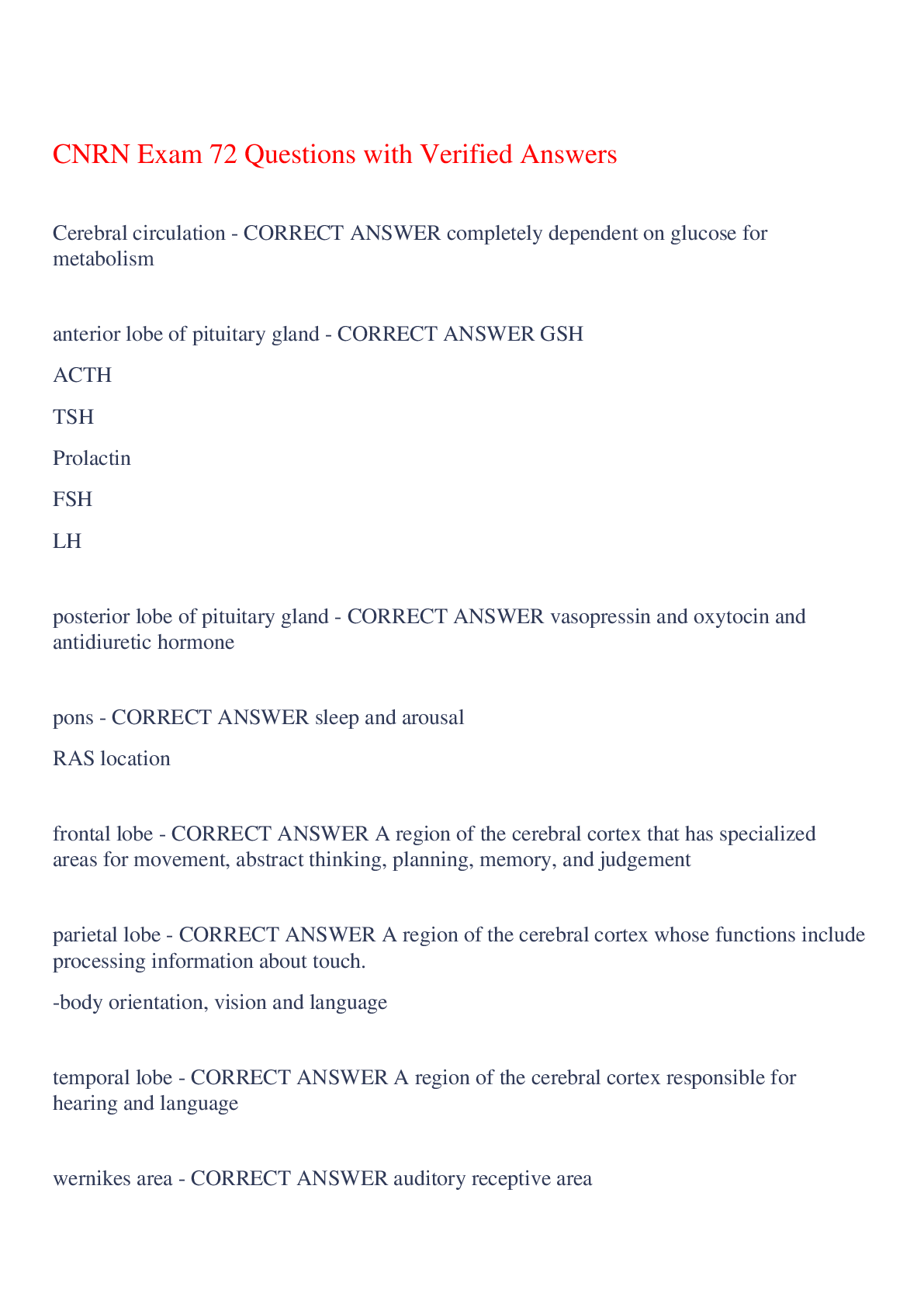
Buy this document to get the full access instantly
Instant Download Access after purchase
Add to cartInstant download
Reviews( 0 )
Document information
Connected school, study & course
About the document
Uploaded On
Oct 24, 2023
Number of pages
11
Written in
Additional information
This document has been written for:
Uploaded
Oct 24, 2023
Downloads
0
Views
83














